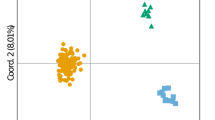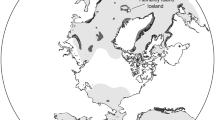Abstract
The Roseate Tern, Sterna dougallii, is an endangered species in the Northwest Atlantic, where it has undergone transient reductions in population size over the past 120 years. This population has been slow to regain former size and range, perhaps in part due to the female-biased sex ratio, which results in female–female pairs, reducing the average productivity of the colony. The larger populations of the Western Pacific and Indian Oceans are not endangered and there is no evidence of a biased sex ratio at breeding in Western Australia. We developed four novel microsatellite markers and adapted one other and these are the first used in the genus Sterna. We also determined the utility of these markers for 17 related species. Here we report the population genetic structure within and between two regions, the Northwest Atlantic and Western Australia. A significant finding is that the Northwestern Atlantic region has much lower allelic diversity than the Western Australia region, promoting the recommendation for increased protection of sites in this region in order to preserve remaining genetic diversity and new potential breeding habitats.
Similar content being viewed by others
References
JC Avise WS Nelson BW Bowen D Walker (2000) ArticleTitlePhylogeography of colonially nesting seabirds, with special reference to global matrilineal patterns in the sooty tern (Sterna fuscata) Mol. Ecol. 9 1783–1792
J Coulson (2001) Colonial breeding in seabirds BA Schreiber J Burger (Eds) Biology of Marine Birds CRC Press Boca Raton, FL 87–114
AD Given JA Mills AJ Baker (2002) ArticleTitleIsolation of polymorphic microsatellite loci from the red-billed gull (Larus novaehollandiae scopulinus) and amplification in related species Mol. Ecol. Notes 2 416–418
M Gochfeld J Burger ICT Nisbet (1998) Roseate Tern (Sterna dougallii) A Poole F Gill (Eds) The Birds of North America, No. 370 The Birds of North America, Inc. Philadelphia, PA
Goudet F (2001) FSTAT, a program to estimate and test gene diversities and fixation indices (version 2.9.3). Available from http://www.unil.ch/izea/software/fstat.html
H Hays P Lima L Monteiro J DiCostanzo G Cormons ICT Nisbet JE Saliva JA Spendelow J Burger J Pierce Gochfeld M (1999) ArticleTitleA nonbreeding concentration of Roseate and Common Terns in Bahia, Brazil J. Field Ornithol. 70 455–464
JJ Hatch P Szczys (2000) ArticleTitleLack of evidence for female-female pairs among Roseate Terns Sterna dougallii in Western Australia contrasts with North Atlantic EMU 100 152–155
CR Hughes D Moralez Deloach (1997) ArticleTitleDeveloping microsatellites when they are rare:trinucleotide repeat loci in the Northern Mockingbird Mimus polyglottos Mol. Ecol. 6 1099–1102
M Isaksson H Tegelstrom (2002) ArticleTitleCharacterization of polymorphic microsatellite markers in a captive population of the eagle owl (Bubo bubo) used for supportive breeding Mol. Ecol. Notes 2 91–93
N Korfanta N Schable T Glenn (2002) ArticleTitleIsolation and characterization of microsatellite DNA primers in burrowing owl (Athene cunicularia) Mol. Ecol. Notes 2 584–585
JD Lebreton JE Hines R Pradel JD Nichols JA Spendelow (2003) ArticleTitleEstimation by capture-recapture of recruitment and dispersal over several sites Oikos 101 253–264
J Longmire D Hahn J Roach (1999) ArticleTitleLow abundance of microsatellite repeats in the genome of the brown-headed cowbird (Molothrus ater) J. Hered. 90 574–578
R Muellenbach PJL Lagoda C Welter (1989) ArticleTitleAn efficient salt-chloroform extraction of DNA from blood and tissues Trend. Genet. 5 391
Nisbet ICT (1980) Status and trends of the Roseate Tern (Sterna dougallii) in North America and the Caribbean. U.S. Fish and Wildlife Service, Report 50181-084-9, Newton Corner, MA
ICT Nisbet JA Spendelow (1999) ArticleTitleContribution of research to management and recovery of the Roseate Tern: Review of a twelve-year project Waterbirds 22 239–252
ICT Nisbet P Szczys (2000) ArticleTitleSex does not affect early growth or survival in chicks of the Roseate Tern Waterbirds 24 45–49
O’Neill P, Minton C, Ozaki K, White R (2003) Three populations of non-breeding Roseate Terns in the Swain Reefs, Australia. 27th Annual Meeting of the Waterbird Society, p. 57
CR Primmer T Raudsepp BP Chowdhary AP Moller H Ellegren (1997) ArticleTitleLow frequency of microsatellites in the avian genome Genome Res. 7 471–482
M Raymond F Rousset (1995) ArticleTitleGENEPOP (version 3.1c): population genetics software for exact tests and ecumenicism J. Hered. 86 248–249
Ross G, Burbridge A. Brothers N, et al. (1995) The status of Australia’s Seabirds. In: State of the Marine Environment Report for Australia Technical ReportsVolume 1: Ecosystems, State and Territory Issues (compiled by Zann, L). Australian Government Department of the Environment and Heritage
JA Spendelow JD Nichols et al. (1995) ArticleTitleEstimating annual survival a d movement rates of adults within a metapopulation of Roseate Terns Ecology 76 2415–2428
Surman C, Moran M, Burbidge A, Wooller R, Gaughan D (2002) Identification and conservation of food fish for Abrolhos seabirds. Final Report for NHT Project 9709
P Szczys ICT Nisbet JJ Hatch R Kesseli (2001) ArticleTitleSex ratio bias at hatching and fledging in the Roseate Tern The Condor 103 385–389
A Thode M Maltbie L Hansen L Green J Longmire (2002) ArticleTitleMicrosatellite markers for the Mexican spotted owl (Strix occidentalis lucida) Mol. Ecol. Notes 2 446–448
C Tirard F Helfenstein E Danchin (2002) ArticleTitlePolymorphic microsatellites in the black-legged kittiwake Rissa tridactyla Mol. Ecol. Notes 2 431–433
AJ Tree NTW Klages (2003) ArticleTitleStatus, biometrics, moult and possible relationships of the South African population of Roseate Tern Ostrich 74 74–80
Author information
Authors and Affiliations
Corresponding author
Rights and permissions
About this article
Cite this article
Szczys, P., Hughes, C.R. & Kesseli, R.V. Novel microsatellite markers used to determine the population genetic structure of the endangered Roseate Tern, Sterna dougallii, in Northwest Atlanticand Western Australia. Conserv Genet 6, 461–466 (2005). https://doi.org/10.1007/s10592-004-4975-6
Received:
Accepted:
Issue Date:
DOI: https://doi.org/10.1007/s10592-004-4975-6




